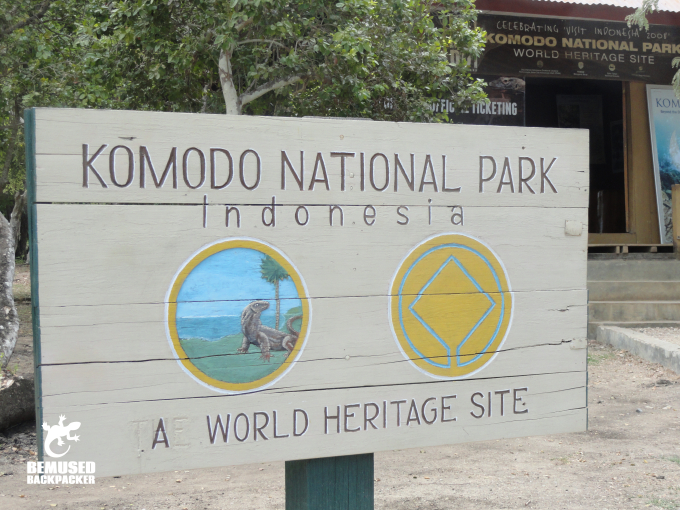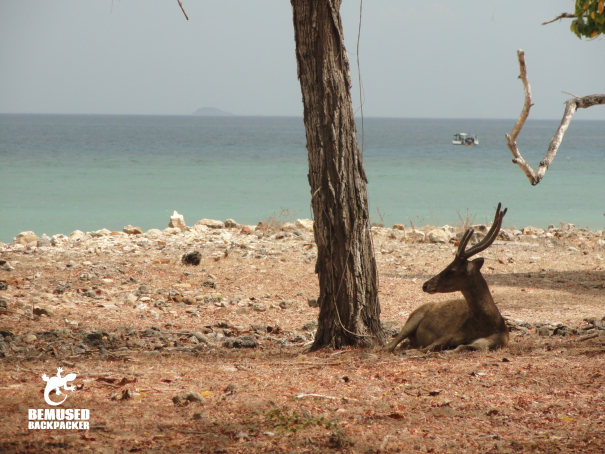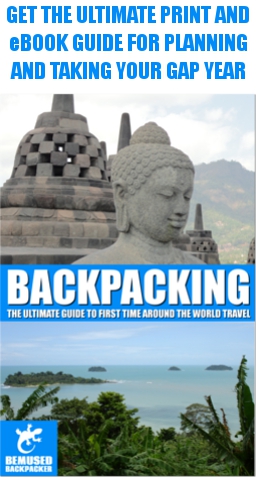
Trekking to the end of the world to the only place you can still see Komodo Dragons in their natural habitat is the ultimate bucket list adventure, and Komodo National Park in Indonesia is a must see destination on any gap year.
This is a paid article written in partnership with the Indonesian Ministry Of Tourism as part of the #WonderfulIndonesia campaign, with products or services supplied by them. Full editorial integrity is maintained at all times. The views and opinions expressed are entirely the authors own based on personal experiences when travelling and are honest and factual without any bias.
Backpacking around the world can lead to you seeing some amazing sights and visiting some truly stunning locations, but every once in a while you arrive somewhere so remote, so magical and so alluringly exquisite that it raises the bar forever.
In this place it is easy to become entranced by the sheer beauty of paradise itself, until that is you realise that you have reached the very end of the Earth. You have travelled so far that you have arrived the part of the world where myth and legend can still be real, you have arrived in the land of the dragon.
Arriving at Labuan Bajo in Flores, it is easy to imagine you are about to set off on an epic expedition. This picturesque and laid back fishing village is the gateway to paradise itself, surrounded by an entire archipelago filled with white powder beaches, lush tropical landscapes and endless islands surrounded by vivid turquoise waters teeming with tropical reefs.

Setting off on the small flotilla of speedboats, I was both excited and serenely nonchalant in equal measure. Nothing is so relaxing as putting your feet up on the roof of a boat as it speeds past one of the most stunning archipelagos on the planet, but I was also keenly aware of the adventure that lay ahead of us. I had wanted to see a Komodo Dragon in the flesh since watching aged wildlife documentaries as a child and imagined them as descendants of the mythical Dragons I had small models of. I had visions in my mind of what exactly lay before us, of the creatures that I have dreamed of seeing in their natural home for as long as I can remember.
No daydream could compare to the reality.
Rinca Island.
It wasn’t long before Rinca island, the closest of the three islands collectively known as Komodo National Park, loomed ahead, the ominously named Crocodile Bay greeting us with a small dock that seemed to be a timeless snapshot of an ancient, mythical place.
I tried to remember exactly when we went over that secret waterfall into the Land Of The Lost as we disembarked from our boats. It was like stepping back in time into a landscape that had not been seen since the Jurassic age, with a rocky climb leading us to a dusty, open Savannah.
It was a landscape that was fitting for the inhabitants.
Just like Professor Lindenbrook’s expedition coming across their first monster in Jules Verne’s Journey To The Centre Of The Earth, it wasn’t long before we came across our own vicious creature. This was no stop motion dinosaur made of Plasticine or an iguana with a cardboard spine stuck to its back, this was a dragon.
A Real, Live Komodo Dragon.

This reptilian behemoth lounged lazily in the midday heat, enjoying the shade of an overhanging tree and lulling it’s prey into a false sense of security as it slowly flicked its tongue, making it look as if it was too big and too ungainly to be much of a threat. Despite the seemingly lethargic demeanor, the dragon had a hint of malevolence in the half open eyes, a sense of urgent threat that made me think very hard about the phrase let sleeping dragons lie, because make no mistake this was no peaceful, overgrown lizard.
The Komodo dragon is 80 kilograms of pure carnivorous aggression and can grow up to 10 foot long. It can take on a full grown buffalo with ease and it’s saliva alone is so deadly a single bite is enough to kill a grown man, letting the Komodo Dragon simply wait until you die and feast at its leisure.

It is a disconcerting feeling realising you are no longer top of the food chain.
Keeping our small group at a distance and eventually moving us on with warnings to not get too close, our guides, expertly trained and experienced rangers, gathered everyone at the ranger station and gave a brief talk on safety. There was a strong emphasis on not allowing visitors to get too close, as this was the Komodo Dragon’s island. This was their home. Their lair. They roamed free with as little impact from us as possible.
The Perfect Blend Of Conservation And Tourism.
I was impressed at how much emphasis the rangers put on responsible tourism. The rangers at this UNESCO world heritage site worked hard to protect the Komodo Dragons, who hold a ‘vulnerable’ status on the conservation scale, and works together with international zoo’s such as San Diego in California for international breeding and conservation programmes.
Conservation programmes and sustainability policies are imposed by the central Indonesian government, and strong community education and empowerment policies are implemented within the local villages to ensure sustainable management and protection of resources. Visitor groups to the island were specifically limited and kept relatively low in number with a management system put in place by the Indonesian government, and were held to strict rules of behaviour to minimize any impact.
The travel experience on Komodo National Park was a fantastic blend of conservation and tourism and the perfect example of how the two can work together.
There were two trails on the island, one short, one long, but the long trail took in the length of Rinca Island including vast plains which the Dragons usually avoided. The longer trail had a stronger emphasis on seeing the island itself as opposed to its inhabitants. So stopping only to allow for a few photographs of the Komodo Dragons that had begun to congregate around the station, the rangers veered away from the trail slightly to allow for their movements and we set off on the short trail.

With so many Dragons beginning to appear around the station, it wasn’t long before we got a glimpse of just how quickly these creatures could move despite their size, and I found myself thinking how effective the rangers quarterstaff would actually be at dissuading the animal if he actually decided to attack.
Moving on quickly, we set off along the short trail which had a stark, alien attraction to it. Dry, dusty Savannah and pockets of thorny vegetation surrounded us as our ranger pointed out a nesting site were a female Dragon had laid and incubated her eggs during the mating season. A variety of other wildlife roamed the island too, including deer and monkeys, and we managed to spot more than a few during our relatively short trek, but all were essentially wild prey for the dominant species. With other Dragons eyeing our group up from a distance, we moved on up the trail.
The Dragons seemed to move away as we climbed further into the interior of the island, and an easy trek through vast plains of dry grassland was starting to turn into a steep climb. The ‘short trek’ was taking us to one of the highest spots on the island, but I was not prepared for the view that greeted us when we reached the top.

The panoramic view of the northern stretch of the island and the bay we had arrived at was worth the effort of getting to this remote part of the world alone. Being in the centre of an irregular volcanic archipelago, Komodo National Park has some of the most spectacular natural coastlines in the world, with perfect stretches of white sandy beaches, dramatic cliffs and crystal clear waters.
But the best was yet to come.

Another short boat ride brought us to the eponymous Komodo Island itself, the largest of the three islands connecting the national park together. Jumping off the boat and walking along the long dock leading to the island itself, we were greeted by a few Dragons right on the beach.
Glaring at us as if trying to decide whether to eat us for disturbing its rest or return to basking in the sun, a huge Komodo Dragon lurched across the rocky sand and I was glad we were on the raised platform of the pier.

Stopping on the short walk along the beach, a brave deer had managed to muster up enough courage to languish near the beach and relax in the midday heat. Watching it in the middle distance as the huge Komodo Dragon – easily a match for it in size and significantly more powerful – prowled not twenty feet away. I braced myself and all at once willed the Deer to run and at the same time readied my camera, thinking at any second now I would have a David Attenborough moment as the Dragon claimed its victim as a snack. This was Natural World Live, a wildlife documentary in better than 4K, 3D high def viewing! But serendipity was seemingly on the deer’s side this time as the Dragon changed direction and walked away from the deer instead.

Thankful that the deer had – for this day at least – managed to escape being eaten, I put my camera away and started to think about my own stomach. I was looking forward to some of the traditional home cooked food offered at one of the raised huts just off the beach, but apparently Komodo Dragons are attracted by strong smells, and a number of rangers stood guard as we ate our simple but delicious meals, only occasionally interrupted by the shouted warning for someone to be careful and move away if one of the beasts decided to get too close to the hut.
It was a truly once in a lifetime experience seeing these magnificently deadly creatures up close. It is absolutely clear that you are a mere visitor in their realm, and are expected to behave as such, and that is exactly the way it should be. This is no zoo where tourists can gawk to their hearts content.
I feel genuinely privileged to have been given the chance to see Komodo Dragons in their natural home, and happy that in this instance, my – and other travellers – chances of doing so is not having a negative impact on them. To the contrary, the profit made from this type of responsible tourism ensures the Dragons home will remain protected and taken care of for a long time.

Despite the magnificent monsters that prowl the exterior of the islands and the difficulty in getting to this remote part of the world, the three islands that make up Komodo National Park, Rinca, Komodo and Padar are each in their own way a stunning paradise that should be on everyone’s bucket list.
Did you enjoy this article? I would love to hear your thoughts in the comments section below or on my Facebook or Twitter pages and please feel free to share it with any or all of the social media buttons. If you want to get more great backpacking tips, advice and inspiration, please subscribe to updates via email in the box to your right.
Related Articles.
How To Plan A Trip To Komodo Island, Indonesia.
Ministry Of Coffee Review, Yogyakarta, Indonesia.
Sri Ratih Cottages Review, Ubud, Bali.
Surviving The Cannonball Run For The Sunrise Tour Of Mount Bromo.
Spotlight On BAWA. Volunteering In Bali.
The Prambanan Temples And The Legend Of The Slender Virgin.
Top 10 Bucket List Destinations In Indonesia.





You have some FANTASTIC pictures in this post! And… well I was glad to experience this amazing place too. I was pleased to see that it was properly managed, that respect for the environment and the animals was the key issue. It truly was a fantastic day.
Thanks Claudia, proper management and responsible tourism makes a huge difference, and it proves it can be done, and done well!
Great post they certainly are magnificent but scary creatures. Good to see safety and responsible tourism taken seriously. What a wonderful experience, thanks for sharing!
Thanks for reading guys, appreciate it. 🙂